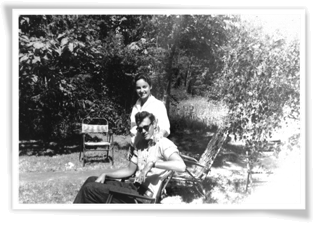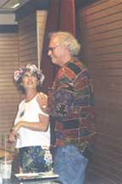|
The GIDGE and i
Brace yourselves, kids: Gigdet is 60! No no, not Sandra Dee or Sally Fields, not Deborah Walley or Cindy Carroll or any of the legions of Gidget impersonators of the big screen or the small screen or even, yes, the stage. We're talking the Real Deal here, the original Gidget, the ür-Gidget you might say, Kathy Kohner Zuckerman herself, whose father, a Hollywood screenwriter named Frederick Kohner, wrote the hugely popular little novel - eponymously entitled Gidget, a best seller in 1957 - that begat all those other Gidgets, and made his daughter Kathy, who inspired it, a legend in the world of surfing. Frederick Kohner's novel is about a high-spirited, vivacious - albeit short - Southern California teen-ager named Franzie and her semi-clandestine adventures with an all-male band of young Malibu surfers, who dub her "Gidget" - a conflation of "girl" and "midget"- and grudgingly admit her to their company, teach her to surf, and even allow her to fall in love with one or another of them on occasion. The book was regarded as mildly scandalous in its day. ("Any parents," fulminated the Nebraska Farmer, "who allow their teen-agers to talk as Gidget does should be soundly spanked.") Nowadays, in the era of Sex in the City, it seems as innocent as Rebecca at Sunnybrook Farm. Still, the Gidget character is a bit of a potty-mouth (it was she who brought the adjective "bitchen" into the language), she cops a smoke now and then, and even knocks back a beer or two when the opportunity presents itself. She is, in her artless girlish way, a rebellious teen spirit from the same cloth as her contemporaries, the James Dean of Rebel Without a Cause, the Brando of The Wild One, Dean Moriarity of On the Road, the young Elvis, Holden Caulfield. So in the fall of 1958, when I and my young wife Kit arrived in Corvallis, Oregon - where, as newly minted Master of the Arts, I had somehow snagged a job at Oregon State College as Instructor of freshman Composition (that's one step above Maintenance and Janitorial) - the conservative (not to say stuffy) little campus was all a-buzz on registration day with the news that the infamous Gidget had enrolled at OSC. And the next thing I knew there she was, right there in the front row of my very first class, a drop-dead cute, Malibu-tanned, feisty-looking little Jewish beach bunny whose natural insouciance made her an enlivening presence amongst all the Presbyterian peaches-and-cream sorority girl home ec. majors.
The OSC administration was as hammer-headed and hide-bound as a congress of warthogs, and strongly discouraged faculty-student socializing. Nonetheless, Kit and I invited Kathy to dinner, and soon she and the first of a succession of new boyfriends were regulars at the frequent parties we threw at our house, which happened to be a few miles out in the country, somewhat secluded, and therefore not immediately subject to administrative scrutiny. Corvallis being pretty much terminally at low tide, Kathy had switched from surfers to football players - all nice guys and all a helluva lot more fun to hang out with than the general run of OSC young fogies. (One of them, for instance, had his pilot's license, and took me up one Saturday morning for my first-ever ride in a small plane; we buzzed the house, and Kit and Kathy stood in the front yard and waved dishtowels at us.) As the loving daughter of a writer, Kathy also envinced a weakness for English teachers - and since she was an irrepressible, irredeemable flirt as well, at our parties those otherwise endearing propensities sometimes combined to get her in hot water with the wives of a few of my more susceptible colleagues. But academic types are nothing if not easily cowed, and the football players and the irked wives, between them, kept my wayward associates more or less honest, and at bay. One of the wives remained a little grumpy, but Kit and I liked Kathy a lot better than we had liked that particular woman anyhow, so our friendship with my favorite student suffered not at all for her small transgressions against on-campus conventions of propriety. Kathy, still dear to our hearts, transferred to a college in Southern California after her sophomore year, and a couple of years later, I finally managed to write my way out of OSC and into Stanford. Somehow, in the shuffle, we lost touch with our young old friend. For the ensuing thirty years or so, I rode the Visiting Lecturer in Creative Writing circuit, bouncing along from one dead-end teaching gig to the next, all without benfit of tenure. The Gidget phenomenon, meanwhile, ran its course, and played itself out. Kit and I called it quits in the mid-70s; I remarried, and eventually landed - as did Kit, coincidentally - back in Kentucky, right where we'd started. In 1985 I published a collection of mostly tongue-in-cheek autobiographical essays called Famous People I Have Known, in which, of course, I mentioned that the Original Gidget had once been in my freshman English class. Somehow (there's that word again), she found out about it, and somehow (neither of us can remember exactly how she did it), she tracked me down in the tiny rural Kentucky town where I was living then, and called me up. From that point on we made sure our lines of communication stayed open; we exchanged notes, we talked on the phone every year or two, I sent her little items of what I like to call McClanahaniana - reviews, articles, pix, and such-like ephemera - and she sent me similar Gidgiana in retaliation. This past spring, when I learned that Berkley Books was to re-issue the old 1957 novel, and that Kathy (as a surrogate for her late father, who died in 1986) would be doing a big book-signing in June at a Santa Monica bookstore, I knew right away that I had to be there. Frederick Kohner's novel is not - nor did it aspire to be - a literary masterpiece. Although he held a Ph.D from the University of Vienna, Kathy's dad understood the literary marketplace; he wrote his sunny little novel in six weeks, and made sure that his girl Franzie steered clear of the existential dark corners that Holden Caulfield mopishly shambled into. Nonetheless, albeit innocently and inadvertantly, Gidget is an important - indeed, a landmark - work of fiction. Consider: Gidget - which is, remember, a novel about a young girl rebelling against parental authority and social convention, and determinedly breaking into what has previously been an exclusively male sub-culture - was published in 1957, a full six years before The Feminine Mystique. Although there are, no doubt, countless very fine girl-coming-of-age novels, there is, to my knowledge, not one - save Gidget - that has achieved iconographic status and stature, not one other youthful female fictional character in all of American literature who can be said to have truly influenced the culture itself in the way that, say, Huck Finn or Dean Moriarity or the ineluctable Holden Caulfield certainly did. Indeed, the very term "coming-of-age novel" suggests boys, boys, nothing but boys. (Full disclosure: I wrote one myself.) But how many young girls, nurtured on Little Women and Nancy Drew and Laura Ingalls Wilder, read Gidget or saw the TV show or one of the movies and said to herself, "Hey, I could do something like that!"? The point being that, much as the very idea might disgust Betty Friedan, Frederick Kohner's innocuous, apolitical little novel was, almost in spite of itself, an essential part of the sub-text of the Women's Liberation Movement of the 60s. The Original Gidget is a granny now, married since 1965 to Marvin Zuckerman, an English prof (of course!) who is currently the Curriculum Dean of Arts and Sciences at Los Angeles Valley College. A couple of years ago, Surfer magazine named her seventh among the most influential surfing figures of all time, on a list topped by Duke Kahanamoku. Wahine, the women surfers' magazine, put her on the cover. Last January, at Waikiki on her 60th birthday, Gidget went Hawaiian one more time, when she climbed on a long tandem board with her surfer pal Bear and shot the curl! Kathy's signing was a hoot. At least two hundred people turned out, at least a hundred of whom were surfers, old and young; there haven't been as many Hawaiian shirts in one room since the ukelele was a cigar box. Bear was on hand, as were half a dozen or so of the old crew - the Go-Heads, she calls them in the book, - including George "Mysto" Carr, who is seventy and has had a triple-by-pass and still surfs "The 'Bu" every day, and sports the deepest tan I've ever seen on a human being. (Mysto could have been constructed of mahogany; if he ever needed spiffing up, you could probably do the job with furniture polish.) These guys - the kids as well as the old hands - revere "The Gidge" as though she were the Mother of the Tides. And the book itself is a delight: The text is unchanged, of course, but it's enhanced by an eloquent introduction by Deanne Stillman, and by Gidge's own foreward and a bundle of antique black and white photos of - think about it - the fictional personnae. It is still the only work of fiction I can call to mind that has (as did the original) a photograph - a photograph, mind you! - of its heroine on the cover. In the novel, the Go-Heads, despite their raging frat-boys-on-a-summer-holiday hormones, ultimately resist the temptation to take advantage of their knowing-yet-naïve teen groupie, and are protective of her; they have their "coozies," but Gidget (sometimes to her dismay) isn't included in that happy number. The Great Kahoona himself (see the movie, with Cliff Robertson in the role) turns down the opportunity. And it was true! Gidget - and Kathy likewise - emerged from the whole adventure with their virtue tested but intact! Nonetheless, there came a moment not included (for pretty obvious reasons) in Kathy's dad's little novel - I'm going to invent the moment's circumstances, though not the essence of it - when Franzie and Moondoggie, the Go-Head she loves best, are parked in Moondoggie's Corvette, top down of course, on the overlook above The 'Bu, and there's a great golden disc of a moon hanging over the wide Pacific, and the sweet little low-tide wavelets are breaking softly on the sands below them, and Moondoggie whispers in the Gidge's tiny seashell ear, "I wish I wish the bottom of my surfboard was as smooth as your breast!" |
|||
|
HOME | THIS ISSUE | ACE ARCHIVES |


